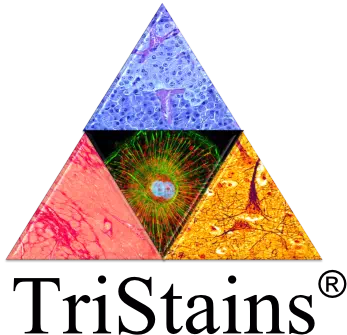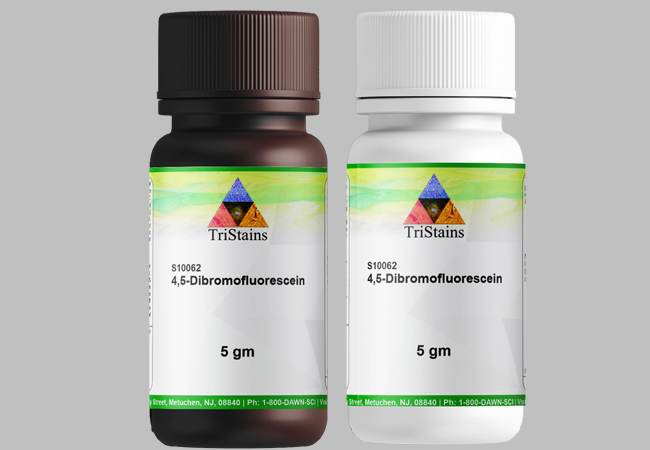4,5-Dibromofluorescein (DBF) is an orange powder and is known as fluorescent dye or a fluorone dye. TriStains® Biological Stains that offer range of stains used in Histology, Cytology, Microbiology and Hematology laboratories. TriStains® meet the highest quality standards and give excellent color performance. TriStains® series products are carefully tested to ensure accurate, reliable, and reproducible results. In this blog, we are going to explore its properties, production methods, uses or applications and safety consideration.
What is 4,5-Dibromofluorescein?
4′,5′-Dibromofluorescein is a fluorescent dye that absorbs light at 370 nm and emits light at 480 nm. It is an orange color powder that can be used in Color Additives. 4,5-Dibromofluorescein belongs to the xanthene dye family and has a complex chemical structure. It consists of a xanthene core with two bromine atoms substituted at positions 4 and 5. It is widely used in medicines and cosmetics coloring.
Its Molecular Formula is C20H10Br2O5. It is also known by other names e.g., 4,5-dibromo-3,6-fluorandiol; Eosinic acid; Solvent Red 72. It has a molecular weight of 490.1 g/mol and has a melting point of approximately 270- 273 °C.
It can be used as an indicator for pH measurements, with a peak emission at 517 nm when excited at 494 nm. It is also used as a diagnostic agent for the detection of human serum in analytical chemistry. This dye has a high fluorescence lifetime, which allows it to be detected by an optical sensor with high sensitivity.

Properties of 4,5- Dibromo fluorescein:
TriStains® 4,5- Dibromo fluorescein is an orange or red powder substance which is a fluorescent dye. It is slightly soluble in water and give orange with faint yellow fluorescence, soluble in ethanol and give orange with greenish-yellow fluorescence and in acetone it will give pink with yellow fluorescence, Red-yellow solution in concentrated H2SO4, turning yellow-brown with orange precipitation on dilution.
Dye aqueous solution to join sodium hydroxide as red edge; In the glycerol and liquid paraffin in good dispersibility.
It can act as a pH indicator due to its color change in response to changes in pH levels. It appears yellow at low pH values and turns pink or red in alkaline conditions. This property makes it useful in analytical chemistry, especially for pH titrations and colorimetric pH measurements.
Preparation of 4,5- Dibromo fluorescein:
Its preparation includes Fluorescein (C.I. Acid Yellow 73, C.I. 45350) in the sodium hydroxide solution two bromination, and made into a free acid form.
Purification Methods:
Crystallise it from aqueous 30% EtOH.

Uses or Applications of 4,5- Dibromo fluorescein:
- Fluorone dyes are hydroxyl-xanthene dyes (homologues of fluorescein) and have been the most widely used class of organic fluorophores for labeling and sensing biomolecules.
- DBF is routinely used as a ligand for studying the properties of protein using spectral analysis.
- It also has chemotherapeutic properties and can be used in the treatment of cancer cells, such as erythrosine-resistant leukemia cells.
- It is widely used as a biological stain in histology and microscopy. It is commonly employed to stain and visualize various cellular components, such as collagen fibers, connective tissues, and mucopolysaccharides.
- 4′,5′-Dibromofluorescein is also used in Cosmetics.
- It is also utilized in the production of inks, especially in the printing industry. It can be incorporated into various types of inks, including water-based and solvent-based inks, for applications such as offset printing and inkjet printing.
- Eosin Y has been used as a dye in the textile industry. Its vibrant red color makes it suitable for dyeing natural and synthetic fibers, imparting bright and intense shades.
- It is employed as a sensitizer in the field of dye-sensitized solar cells (DSSCs). It enhances the absorption of light and improves the efficiency of light harvesting in these photovoltaic devices.
Safety Consideration:
» 4′,5′-Dibromofluorescein is toxic and must be handled with care. If it is ingested or inhaled, then it may cause skin irritation, eye irritation and may cause respiratory irritation upon contact.
» Personal protective equipment such as gloves and eye protection should be used during handling of 4,5- Dibromo fluorescein. If it causes on skin, wash with plenty of soap and water. If in eyes, then rinse continuously with water.
» If it inhaled, Persons with impaired respiratory function, airway diseases and conditions such as emphysema or chronic bronchitis, may incur further disability if excessive concentrations of particulate are inhaled. Not normally a hazard due to non-volatile nature of the product.
» It is Poison by ingestion and intravenous routes and one type of an herbicide. When it is heated to decomposition it emits highly toxic fumes of NOx, CN-, and Br-.
Storage Information:
» It should be Stored in original containers. Keep containers securely sealed. Store away from incompatible materials and foodstuff containers. Protect containers against physical damage and check regularly for leaks.
» It should be stored in a cool, dry and well-ventilated place away from sources of heat or ignition to prevent degradation.
Where To Buy
» Buy premium quality Biological stain & Indicators from TriStains®. All TriStains® Products are exclusively distributed by Dawn Scientific Inc.
About TriStains® Brand
Biological Stains are a major part of all Histology, Hematology and Cytology labs and we understand that quality is of utmost importance, so try Premium quality biological stains TriStains® see the difference. TriStains® offers all types of stains and indicators in ready to use solutions as well as solid forms for more information please visit our website www.tristains.com or email us on [email protected] for any Query/information we will be happy to help you.
Disclaimer: All the information on this blog is published in good faith and for general information purposes only. The information contained in this Blog might be provided on an “as is” based on Wikipedia, Google and other scientific articles. We are not liable for any injuries or damages for the use of your information. Please do your own research before you use this information for any purpose.





